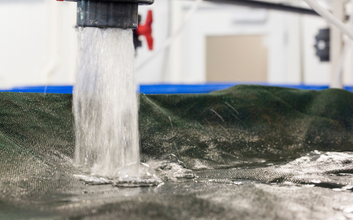Water Quality in Aquaculture
Why is water quality important in aquaculture?
Water quality is an essential factor in aquaculture. Unlike terrestrial animals, aquatic organisms are immersed in water. Therefore, all of their important metabolic processes occur in water, including feeding, digestion, excretion, and growth. These organisms are sensitive to any change in water quality, especially in high stocking densities.
It is, therefore, vital that water quality is monitored regularly to ensure optimum levels are maintained. Some of the most critical parameters to consider include temperature, dissolved oxygen, pH, ammonia and nitrites.
The impact of poor water quality on aquaculture
Fish health can be determined by the quality of the water. Of all the water quality parameters that affect fish and shrimp, ammonia and oxygen are the most crucial, especially in intensive culture systems.
Maintaining optimum levels of dissolved oxygen in water is key to ensuring maximum productivity. Any fluctuation on this level will increase the stress levels in fish and shrimp. These levels must be checked daily, as they fluctuate frequently. Oxygen is required for breathing, and this varies depending on the size of the fish and shrimp and their metabolic rate. If cultured at the optimum oxygen levels, this will help reduce unnecessary stress and increase productivity.
Overcrowding in farming environments leads to poor water quality because of decreased dissolved oxygen levels and the accumulation of highly toxic metabolic wastes, such as ammonia. Ammonia is considered one of the most toxic substances in water quality parameters, as it can cause stress and gill damage, even in small amounts. Fish exposed to low levels of ammonia over time are more susceptible to bacterial infections, grow poorly and have less tolerance to routine handling.
Ammonia is a killer when present in higher concentrations, and many unexplained production losses have been linked to this harmful substance.
Waste particles can be a major source of water pollution if not correctly managed. These particles contain nitrogen and, in high quantities, can seriously impact fish gills. Feed must precisely meet the nutritional requirements for each species — this will result in optimal growth and performance and minimal waste. If you are operating a RAS facility, this is especially critical but also applies to all aquaculture environments. Read more.
Strategies to improve aquaculture water quality
Semi-intensive or intensive farming
Farming in an intensive environment requires optimal water quality if fish and shrimp are to live a healthy life and grow to their full potential. Supplementing with chelated minerals means that the nutrient is more bioavailable and less prone to negative interactions with other dietary ingredients. Fish and shrimp, thereby, retain more nutrients and utilize them better throughout their body. If these nutrients are not utilized, a high amount will be excreted into the water and cause unnecessary stress on their immune defense systems. Appropriate mineral management is key to supporting optimal health and performance, in addition to maintaining water quality.
Promote natural defenses
Aquate® has been formulated to meet several specific requirements of each aquatic species. It enhances biomass production, boosts natural defense systems and encourages healthier and more robust aquatic populations. Aquate combines the right amount of chelated minerals and yeast-based additives. The optimal inclusion levels will aid in digestion and nutrient absorption and utilization. This will not only result in healthier fish but also lower feces production and pollution in farming systems.
Pond farming
Ponds that have a high pH or use high-protein feeds can often have problems with ammonia. Bacteria and phytoplankton can assimilate nitrogenous compounds, such as ammonia, nitrite and nitrate, into protein. However, the rate at which they do so often cannot keep up with the rate of ammonia and nitrite generation, especially when feeding rates are high. This can lead to the build-up of toxic levels of ammonia, especially when pH is high.
Three major sources for the production and accumulation of ammonia in aquaculture ponds are:
- Excretion from fish and shrimp
- Degradation of waste feed
- Degradation of dead plants and animals
Defend against ammonia’s harmful effects
Improving water quality without the harmful effects of chemicals is crucial for fish health. One solution that comes straight from nature — more specifically, the desert — is the yucca schidigera plant. De-Odorase® is a product that contains yucca plant extract, which acts to reduce ammonia in water, preventing it from reaching harmful levels.
Benefits of De-Odorase®
- Binds ammonia, preventing the accumulation of ammonia and nitrite in water
- Active at a wide range of salinities
- Maintains water quality and facilitates normal functioning of aquatic animals
- Reduces the growth of filamentous algae
- Assists in overall performance, including increased feed intakes, better conversion, optimal growth, increased survival, higher yields and enhanced profits
De-Odorase is fast-acting, so it can also be used to treat ponds when ammonia levels become too high, especially later in the culture cycle when feed input is high. Field tests have even shown that De-Odorase can minimize harmful ammonia levels in as little as one hour after treatment.













